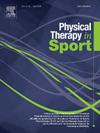Investigating peroneus muscle quality in ankle stability: A comparative analysis between chronic ankle instability patients and healthy controls
IF 2.2
3区 医学
Q1 REHABILITATION
引用次数: 0
Abstract
Objectives
To compare peroneal muscle quality between individuals with chronic ankle instability (CAI) and healthy controls, and to examine their relationship with ankle stability.
Design
Case-control study.
Setting
Sports Medicine research laboratory.
Methods
Sixty-five participants (35 with unilateral CAI, 30 healthy controls) were assessed. Peroneal muscle size, echogenicity, and passive stiffness were measured using ultrasound imaging and eversion strength was assessed with a hand-held dynamometer. Ankle stability was evaluated using the Y Balance Test (YBT), lateral step-down, and single-leg stance tests.
Results
Compared to controls, individuals with CAI showed significantly lower eversion strength, higher muscle echogenicity, and increased passive stiffness. In the CAI group, greater stiffness and reduced strength were associated with higher centre of pressure displacement during single-leg stance. Higher eversion strength was associated with increased YBT scores across all participants. Echogenicity was not directly associated with stability functions.
Conclusion
Deficits in peroneal muscle quality, involving echogenicity, strength and stiffness, are demonstrated in the CAI population. These factors are associated with impaired instability among CAI individuals. Interventions targeting peroneal muscle quality may improve balance and reduce the risk of recurrent ankle injuries in this population.
研究踝关节稳定性中的腓骨肌质量:慢性踝关节不稳定患者与健康对照的比较分析
目的比较慢性踝关节不稳定(CAI)患者与健康对照者腓肌质量的差异,并探讨其与踝关节稳定性的关系。DesignCase-control研究。设置运动医学研究实验室。方法对65例患者(单侧CAI 35例,健康对照30例)进行评估。腓肌大小、回声性和被动僵硬度采用超声成像测量,外翻强度采用手持式测功仪评估。踝关节稳定性通过Y平衡试验(YBT)、横向降压和单腿站立试验进行评估。结果与对照组相比,CAI患者的外翻强度明显降低,肌肉回声增强,被动僵硬度增加。在CAI组中,在单腿站立时,更大的刚度和强度降低与更高的压力中心位移相关。在所有参与者中,更高的强度与更高的YBT分数相关。回声性与稳定性函数无直接关系。结论在CAI人群中存在腓骨肌质量缺陷,包括回声、力量和僵硬。这些因素与CAI患者的不稳定性受损有关。针对腓骨肌质量的干预措施可以改善平衡并降低该人群复发性踝关节损伤的风险。
本文章由计算机程序翻译,如有差异,请以英文原文为准。
求助全文
约1分钟内获得全文
求助全文
来源期刊

Physical Therapy in Sport
医学-康复医学
CiteScore
4.50
自引率
8.30%
发文量
125
审稿时长
39 days
期刊介绍:
Physical Therapy in Sport is an international peer-reviewed journal that provides a forum for the publication of research and clinical practice material relevant to the healthcare professions involved in sports and exercise medicine, and rehabilitation. The journal publishes material that is indispensable for day-to-day practice and continuing professional development. Physical Therapy in Sport covers topics dealing with the diagnosis, treatment, and prevention of injuries, as well as more general areas of sports and exercise medicine and related sports science.
The journal publishes original research, case studies, reviews, masterclasses, papers on clinical approaches, and book reviews, as well as occasional reports from conferences. Papers are double-blind peer-reviewed by our international advisory board and other international experts, and submissions from a broad range of disciplines are actively encouraged.
 求助内容:
求助内容: 应助结果提醒方式:
应助结果提醒方式:


